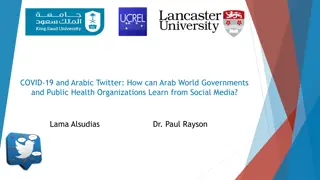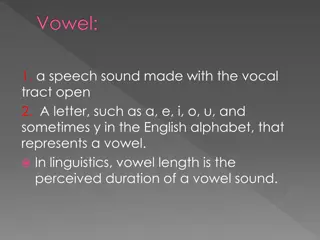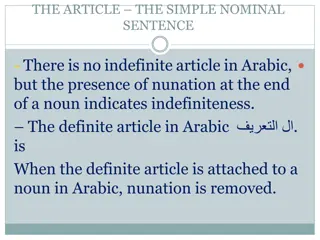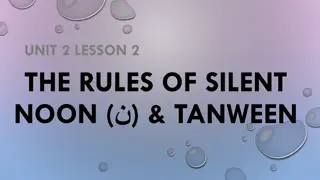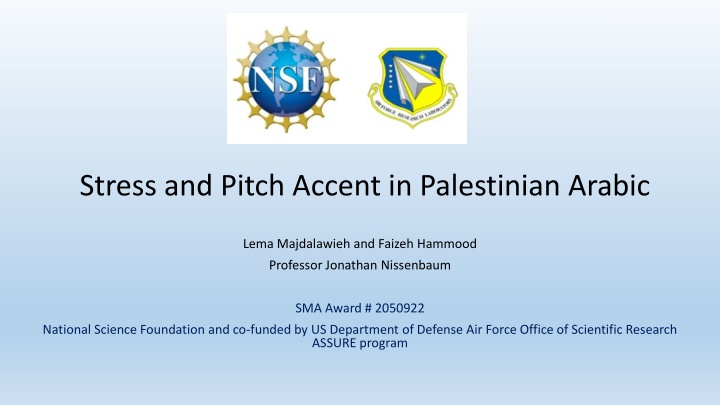
Stress and Pitch Accent in Palestinian Arabic Phonology
Explore the phonological properties and physical attributes of stress and pitch accent in Palestinian Arabic, investigating the interaction between fundamental frequency and duration. Research delves into the prominence conveyed through syllables and linguistic implications.
Download Presentation

Please find below an Image/Link to download the presentation.
The content on the website is provided AS IS for your information and personal use only. It may not be sold, licensed, or shared on other websites without obtaining consent from the author. If you encounter any issues during the download, it is possible that the publisher has removed the file from their server.
You are allowed to download the files provided on this website for personal or commercial use, subject to the condition that they are used lawfully. All files are the property of their respective owners.
The content on the website is provided AS IS for your information and personal use only. It may not be sold, licensed, or shared on other websites without obtaining consent from the author.
E N D
Presentation Transcript
Stress and Pitch Accent in Palestinian Arabic Lema Majdalawieh and Faizeh Hammood Professor Jonathan Nissenbaum SMA Award # 2050922 National Science Foundation and co-funded by US Department of Defense Air Force Office of Scientific Research ASSURE program
General Introduction Big research question: What is the phonology of stress and accent in Palestinian Arabic? Significance: Contributing to the cross linguistic research of how prominence is conveyed.
Background 1: Phonological properties Background 1: Phonological properties Stress: Syllable prominence within a given word and is assigned by lexical-phonological rules. [hesitate] - [hesitation] Pitch Accent: Intonational contour aligned with stressed syllables. (H*/L*) [She hesitated.] - [She hesitated?] H* L* Nuclear Accent: Final pitch accent of an utterance the focused word of the sentence. [She hesitated to eat the lentils.] H* H* H* [SHE hesitated to eat the lentils.] H*
Background 2: Physical properties of the signal Background 2: Physical properties of the signal Fundamental frequency (f0): the mean number of vocal cord oscillations per second; f0 underlies perception of pitch. Correlates with Pitch Accent / Focus Duration: the length of time that a segment lasts; duration of a vowel often correlates with stress.
Specific Narrow Research Question and Hypotheses Narrow research question: How do fundamental frequency and duration interact when we vary stress and pitch accent in Palestinian Arabic? - There is a three-way distinction for any syllable: - Accented & Stressed syllables; Unaccented, stressed syllables, Unstressed syllables Hypotheses: We expect to find a two (or possibly 3?) way correlation of F(0) and the three syllable types. We expect to find a three-way correlation between duration and the three syllable types. Null hypothesis: both duration & f0 differences will be gradient, not categorical (no 2- or 3-way distinction)
Methodology Six dialogues in P.A. are being read out loud (and recorded) by 9 native speakers of P.A, with adults ages ranging between 21-53 years old. The dialogues represented conversations between two friends Each dialogue contains a target syllable [mad] The target syllable varies between being STRESSED or UNSTRESSED, and also in whether it has a (H* or L*) pitch accent, or is unaccented. The goal was to measure fundamental frequency and duration of the target syllable in each of the phonological conditions.
Dialogues 1-2: Target syllable is accented accented (H* or L*) Dialogue 1: SPEAKER A: (Inti) ruhti al maktabeh? SPEAKER B: La? ana ruhit al madraseh. Did you go to the library? No, I went to the school. H* ( L ) Dialogue 2: SPEAKER A: (Inti) ruhti al madraseh? Did you go to the school? L* ( H ) SPEAKER B: La? ana ruhit al maktabeh. No, I went to the library.
Dialogues 3-4: Target syl. unstressed unstressed but in an accented word Dialogue 3: SPEAKER A: (Inti) ruhti ala maktabtik? Did you go to your library? SPEAKER B: La? ana ruhit ala madrasti. No, I went to my school? H*( L ) Dialogue 4: SPEAKER A: (Inti) ruhti ala madrastik? Did you go to your school? L*( H ) SPEAKER B: La? ana ruhit ala maktabti. No, I went to my library?
Dialogues 5-6: Target syl. is either stressed or unstressed but in an unaccented unaccentedword (post-nuclear) Dialogue 5: SPEAKER A: Hiya rahat al madraseh? Did she go to the school? L* ( ... H .. ) SPEAKER B: La? hoowa rah al madraseh. No, he went to the school. H* ( ... L .. ) Dialogue 6: SPEAKER A: Hiya rahat ala madrastak? Did she go to your school? L* ( ... H .. ) SPEAKER B: La? hoowa rah al madrasti. No, he went to my school. H* ( ... L .. )
Methods The study entailed a sample of 9 participants who were native Palestinian Arabic speakers. Participants took an average four to five minutes to complete the task. Recordings of the 6 dialogues were taken using voice memos on iPhone and then uploaded to software voice analysis, Audacity for investigation. After recordings were sent to us, we then annotated 5 of them through the software. After annotating the recordings we measured all the target words: We measured the duration of each target syllable We measured the f0 change within each target word
Further Questions Although the study looked at how stress and pitch interacted in speech, further questions include: Whether stress affects the differential changes in f0 between focused and unfocused words in Palestinian Arabic. Whether focus impacts the difference in duration between stressed and unstressed syllables.





